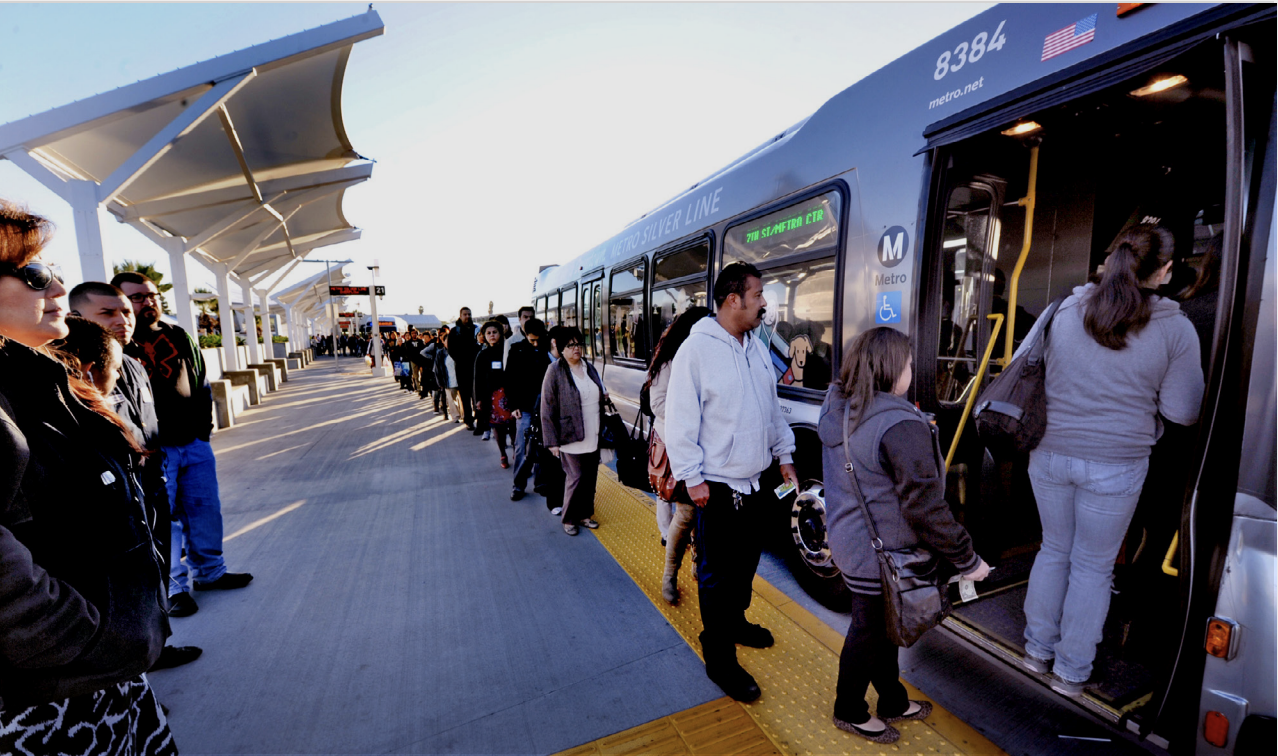
At most transit agencies, “who decides” is quite different from “who rides.” Our latest report, “Who Rules Transit?” reveals a yawning gap between the demographics of transit riders – primarily women and people of color – and leadership at transit agencies – primarily white men.
This problem manifests in numerous ways.
Transit agency boards have significant authority over the policies that impact service, but are often unrepresentative of transit riders.
Our research into the demographics of 108 transit board members in 11 cities found that only 36% are people of color, compared to 58% of the total population and 63% of transit riders. In the same sample, only 30% of board members are women, compared to 51% of the total population and 51% of transit riders. In some regions the disparity is much worse: Women account for merely 13% of SEPTA (Philadelphia) board members, 14% of the Washington Metropolitan Area Transit Authority board, and 20% of the Dallas Area Rapid Transit board.
Geographically, suburban jurisdictions (which are often whiter and higher income but with lower ridership per capita than urban jurisdictions) tend to be overrepresented on transit agency boards relative to population or ridership. The geographic disparity is often rooted in statutes or intergovernmental agreements which grant more board seats per capita to suburban jurisdictions than to the region’s principal city, where most of the transit riders live.
In SEPTA’s case, 38.39% of the service area’s residents and 70.84% of its transit riders live in Philadelphia, yet only 13.33% of the board seats are allocated to the city’s representatives. And in the MTA service region, 63.24% of residents and 88.11% of transit riders live in New York City, yet only 18.18% of the board seats are allocated to appointees of the city.
While boards don’t make granular decisions over service changes or individual hires, they do set overarching policies that guide those decisions and affect who benefits from transit service. These responsibilities include adopting budgets and capital plans, selecting and evaluating the agency CEO, and endorsing major policies like the agency’s level of service standards, labor agreements, fare policies, and major procurements. With boards disconnected from the lived experiences of transit riders, it’s no wonder there’s often a gulf between agency priorities and what riders want.
This power disconnect also presents itself in the bifurcation between transit labor and transit leadership. Frontline workers have particular expertise about day-to-day operations and regularly interact with the public. But too often they are shut out of decision-making at agencies, without representation at the board level or consistent means of communication with executive leadership.
This has severe consequences. In cities across the country, transit agencies are currently struggling to hire and retain enough workers to provide scheduled service, a crisis fueled in large part by dissatisfaction with working conditions.
There is a racial dimension to this power imbalance. In the public transit workforce, 66% of managerial and leadership positions are held by white people, despite accounting for only 40% of transit riders, while people of color are underrepresented in every area of the industry despite making up a majority of transit riders.
Black transit workers make up a quarter of the entire transit workforce and 27% of frontline workers, but less than 20% of managerial positions.
The report describes how some agencies, like Baltimore MTA, are creating internal structures to provide frontline transit staff with a stronger voice and greater influence over the decisions that affect their work.
This is a time of transition and opportunity for transit agencies. Travel patterns are shifting as a result of the pandemic. At the same time, the federal infrastructure package is funneling billions of dollars for new capital investment. Agencies have to make big decisions about how to run service today and how to plan for the future. To make smart choices, agencies have to prioritize the interests of transit riders. But the executive structure and decision-making process at many transit agencies disempowers riders and frontline workers.
To avoid misallocating resources, agencies have to prioritize their interests. That will require overcoming biases in the executive structure at many transit agencies. The full report diagnoses the problem and provides case studies of agencies that have taken steps to give transit riders and workers more power in the decision-making process.
Please join us for a “Who Rules Transit?” kick-off event on May 3rd with New Orleans Mayor LaToya Cantrell, who has made increasing rider representation on the RTA board a centerpiece of her mayoralty.
 On the Brink: Will WMATA’s Progress Be Erased by 2024?
On the Brink: Will WMATA’s Progress Be Erased by 2024?
The experience of being a WMATA rider has substantially improved over the last 18 months, thanks to changes the agency has made like adding off-peak service and simplifying fares. Things are about to get even better with the launch of all-door boarding later this fall, overnight bus service on some lines starting in December, and an ambitious plan to redesign the Metrobus network. But all of this could go away by July 1, 2024.
Read More To Achieve Justice and Climate Outcomes, Fund These Transit Capital Projects
To Achieve Justice and Climate Outcomes, Fund These Transit Capital Projects
Transit advocates, organizers, and riders are calling on local and state agencies along with the USDOT to advance projects designed to improve the mobility of Black and Brown individuals at a time when there is unprecedented funding and an equitable framework to transform transportation infrastructure, support the climate, and right historic injustices.
Read More